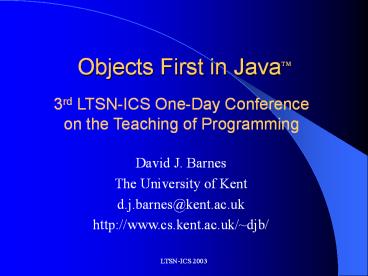Objects First in Java? - PowerPoint PPT Presentation
1 / 18
Title:
Objects First in Java?
Description:
http://www.cs.kent.ac.uk/~djb/ 3rd LTSN-ICS One-Day Conference. on the Teaching of Programming ... public static void main(String[] args) throws IOException ... – PowerPoint PPT presentation
Number of Views:66
Avg rating:3.0/5.0
Title: Objects First in Java?
1
Objects First in Java?
3rd LTSN-ICS One-Day Conference on the Teaching
of Programming
David J. Barnes The University of
Kent d.j.barnes_at_kent.ac.uk http//www.cs.kent.ac.u
k/djb/
2
What do I mean by objects first?
- An approach that focuses on the key features of
objects - Objects have state.
- Objects have behaviour.
- An objects state can affect its behaviour.
- An objects behaviour can affect its state.
- Lets start with a journey ...
3
A teaching-language journey
- Pascals domination in the 1980s.
- C, C, ... as a second language.
- The search for a replacement in the early 1990s.
- We chose Modula 3.
- Others chose ...?
- Meanwhile, OO was gradually moving down through
the curriculum.
4
The three (OO) bears
- In the late 1990s, it was time for another
change. - Smalltalk was too niche.
- C was too scary.
- Java was just right.
- Modern.
- Applets (web).
- Graphics.
- Could be taught like Pascal.
5
Main-method hello-world
public class MyFirstProgram public static
void main(String args)
System.out.println("hello, world")
6
Main-method input handling
import java.io. public class EarlyProgram
public static void main(String args) throws
IOException DataInputStream in
new DataInputStream(System.in) int
number Integer.parseInt(in.readLine())
System.out.println(number " squared "
(number number))
7
Applet hello-world
import java.applet.Applet import
java.awt.Graphics public class MyFirstApplet
extends Applet public void paint(Graphics
g) g.drawString("hello, world", 10,
10)
8
Applet input handling
public class EarlyApplet extends Applet
implements ActionListener private TextField
input new TextField(5) private Label
result new Label(" ")
public void init()
input.addActionListener(this)
add(input) add(result)
public void actionPerformed(ActionEvent ev)
int number Integer.parseInt(input.getTex
t()) result.setText(number " squared "
(number number))
9
Where is the OO in this?
- Early examples are critical to the success of
teaching OO. - None of these examples really addresses how to
teach OO. - The design of Java doesnt really do us any
favours in this respect. - We need help in overcoming Javas syntactic
barriers.
10
Enter BlueJ
- BlueJ is a free interactive Java environment.
- Designed specifically to support introductory
teaching of Java. - Designed to support an objects-first approach.
- Developed originally at Monash University by
Michael Kölling and John Rosenberg. - Michael is now at the University of Southern
Denmark. - Development work continues actively.
- See http//www.bluej.org/
11
BlueJ Demo
12
Key issues from the demo
- We can introduce classes and objects from the
start, without having to stumble over syntax. - Objects become real
- We can interact with their methods.
- We can inspect their state.
- We can observe how their state changes in
response to method calls.
13
Rethinking course structures
- Having started with real OO, we can rethink what
comes next. - Textbooks are traditionally organised by language
construct - Assignment, if statements, loops, arrays, etc.
- We can make these topics the servants of an
objects-first approach rather than the masters.
14
Some suggestions
- Emphasise the use of constructors for
initialising state. - Introduce if-statements as a means to protect and
guarantee the state of an object. - Introduce collections of objects early.
- Use ArrayList or LinkedList in preference to
fixed-size arrays. - Introduce while-loops as a means to iterate over
a collection.
15
Use large (interesting!) examples
- Dont be afraid to use large examples.
- Let students see the code.
- Partition the code properly into separate
classes. - Write and document the code well.
- They will provide collateral learning
opportunities.
16
Inheritance
- There is no need to introduce this very early.
- Start by introducing inheritance purely as
extension/reuse. - Javas extends word nicely suits this approach.
- Consider introducing abstract classes in
association with method overriding. - Where there is no obvious common behaviour
between sibling classes.
17
Summary
- If we are going to use an OO language, it makes
sense to teach it using OO principles. - We may still be labouring under the weight of the
Pascal heritage. - An environment like BlueJ frees us from some of
Javas unhelpful syntax. - A proper objects-first approach is possible.
18
Acknowledgements
- Although I have played no part in the development
of the BlueJ environment, I have been fortunate
to work closely with both Michael Kölling and
John Rosenberg. My thinking in this area has
clearly been strongly influenced by their work.































